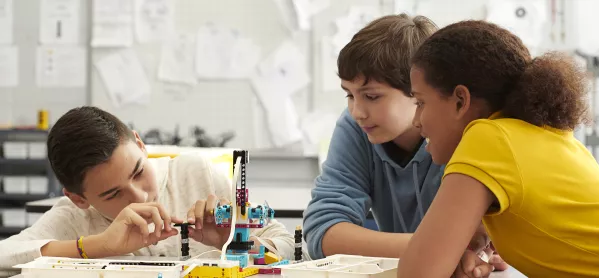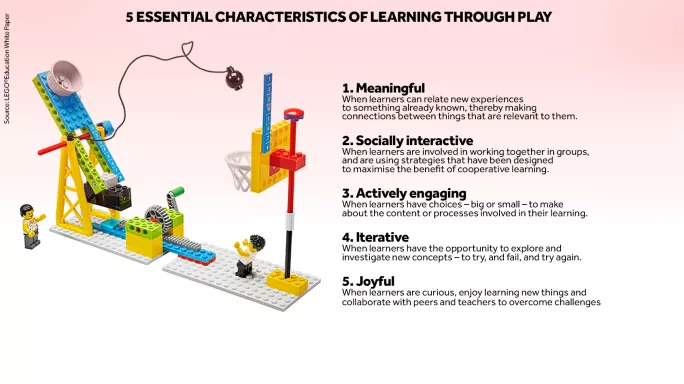Purposeful play can boost engagement in hybrid learning

Twelve-year-old Sophie is sitting at the kitchen table, watching her teacher deliver a live online lesson.
A sprained ankle has meant she’s three hours into a day of remote learning, and although it’s her favourite teacher on screen, her attention is starting to drift. Last week, her friend Liam had the same issue when he was recovering from an operation at home. And the month before, when the school was shut due to snow, the entire class struggled.
While it’s brilliant that students can connect to learning from home, too much screen time can be disengaging and unproductive.
But, for Sophie, things change quickly: just as her attention wanders, her ears prick up.
“For the next task, I want you to close your screens, take 30 minutes to find materials and build me a moving vehicle,” says her teacher. Learning about kinetic energy just got interesting. Suddenly reengaged, Sophie grabs what she can find and gets to work, and when her class return to school the next day, the first thing they talk about is what vehicle they built.
Engaging students when learning from home is no easy feat, and it’s something many teachers have struggled with during the pandemic - but introducing a hands-on playful learning experience could offer a great solution.
Related: Hands-on learning builds Steam confidence
In case you missed it: How to teach through play
Further reading: Stem learning has a bright future and an important past
For Liz Hillawi, an assistant headteacher at Gosport and Fareham Multi-Academy Trust, play-based education - like the activity Sophie experienced - is essential to making sure hybrid learning is accessible, engaging and meaningful.
“We got to February and there had been a lot of online learning. We put in activities that said, close your computer, go and do this, take a photo of it and send it back to us,” she says. “We don’t know what’s going on at home: what computer access they’ve got, how fast their internet is, how long it’s taking them to achieve the hour’s lesson we’re putting in front of them. It gave them a little bit of mental break: play-based learning has really, really helped with that.”
Fulham Prep School in London also introduced an element of play-based learning during the most recent lockdown. Brendan O’Keeffe, head of Year 6 and digital learning, said the feedback from parents was brilliant.
“We were looking for any way to offload some of the staring at the screen, and the natural slide towards it being like a lecture. For 10-year-olds, it’s hard for them, doing that for six hours a day,” he says.
“If you can offer something that gets them away from the screen, it really engages them in a playful way. Parents were really clear in their feedback that they were thankful for the time away from the computer.”
Education consultant Ruth Swailes says it’s absolutely essential that learning through play is included in hybrid learning.
“We sideline play at our peril,” she says. “One of my concerns during the last lockdown was that, for the foundation stage, remote learning is really tricky, and we were trying to do too much “teacher talk” rather than allowing some exploratory play as well. It’s about balance: this shouldn’t devalue play.”
Often, learning through play is limited to the early years, but Hillawi and O’Keeffe are big advocates for using it to engage older students, particularly in Steam subjects (science, technology, engineering, arts and maths).
“Some secondary kids ask: ‘what do you mean, we can play?’ It’s like it’s drummed out of them and we’re now trying to put it back in,” Hillawi says. “It’s so important because it’s keeping that inquisitive learning style which disappears so easily. People have hobbies because they enjoy them, they play and tinker around with something. That’s what we’re trying to cultivate.”
So, how effective is learning through play when teaching Steam?
According to a survey completed by The Harris Poll and LEGO® Education, 95 per cent of educators believe the number one way their students can build confidence in Steam subjects is working on hands-on projects with others, and 57 per cent of students say they need “hands-on experience and tools” to master Steam subjects. And 87 per cent of students say they tend to remember the topics longer when learning through hands-on projects.
Seeing these benefits first-hand, O’Keeffe says he utilises a product that everyone recognises from their childhood: LEGO®. Once a week, LEGO® Education BricQ Motion boxes appear: and pupils know the next hour will be full of possibilities.
“Many have already used LEGO® and are huge fans. When I tell them, today, we’re going to be using LEGO® Education, it’s not a hard sell,” he laughs.
The boxes come with instructions, but pupils don’t have to follow them. That’s key in making the play accessible to everyone, says O’Keeffe. He remembers an engineering lesson where he asked his class to build a mechanism which moved a LEGO® minifigure from one space to another.
“One pupil built a lift using a winch; another built a ski lift. For some, it was a struggle, creative ideas didn’t come to mind straight away, and they didn’t feel like they understood mechanisms,” he says. “So I said, why don’t you build a vehicle and then go and see what Billy or Sarah are doing? It’s really accessible for all of them, no matter what their ability.”
It’s about fostering exploratory and collaborative skills so students are comfortable working things out for themselves and learning how others might approach tasks. As the workplace continues to change rapidly, those skills are key to young people thriving in their future careers.
Self-regulation - the skill of being able to monitor and manage your energy states, emotions, thoughts and behaviours in ways that are acceptable - is another key skill fostered in both play-based education and working independently from home through a hybrid-learning model, says Swailes.
“Research shows children who have really good self-regulation at an early age are significantly more likely to go on to do better in later life than children who are good readers and writers at an early age,” she says.
Hillawi, who also makes use of LEGO® Education’s solutions including SPIKE™ Prime and BricQ Motion, says she’s noticed an increase in pupils’ resilience. “In any kind of play, things don’t work. You have to work with other people in most play situations and think in a different way. It’s really useful for lots of subjects to give that creativity where there is no wrong answer,” she says.
And so, whether it’s to foster those lifelong skills or to provide a much-needed screen break, Hillawi, O’Keeffe and Swailes are all in agreement: learning through play is absolutely crucial for hybrid learning.
Here are a few hands-on activities educators can embed in hybrid education:
- In science, combining different ingredients to witness chemical reactions in real-time.
- For design and technology classes, constructing model buildings or scales from every-day household equipment.
- In music, give students different-coloured and -sized bricks to represent different notes and move them to mimic rhythm and pace.
- For an engineering class, task students with developing a motorised air freshener: they can build and decorate a paper fan and affix it to a sweet tin decorated and filled with homemade potpourri. A small motor can then be attached to the fan over the tin so that it aerates the fragrance.
- In sport, ask students to track how the length of a rope might change how many jumps they can make in one minute. Ask them: which rope length allowed jumpers to skip the fastest/slowest? Did this change for different jumpers? Did height have an impact? Did the length of the rope impact endurance?

